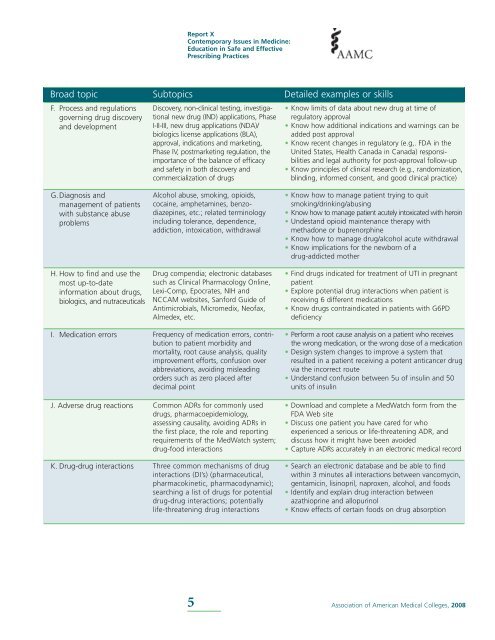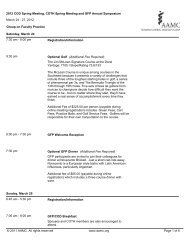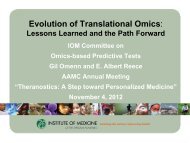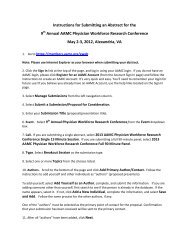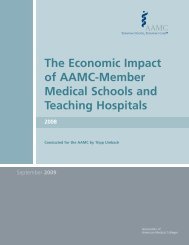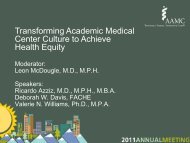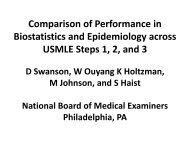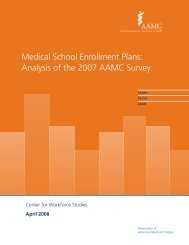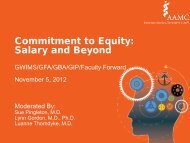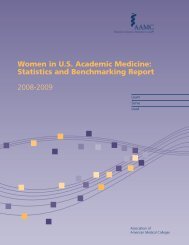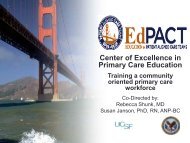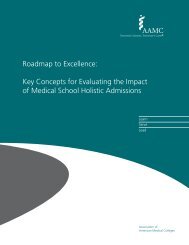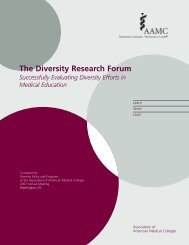Education In Safe and Effective Prescribing Practices - AAMC's ...
Education In Safe and Effective Prescribing Practices - AAMC's ...
Education In Safe and Effective Prescribing Practices - AAMC's ...
You also want an ePaper? Increase the reach of your titles
YUMPU automatically turns print PDFs into web optimized ePapers that Google loves.
Report X<br />
Contemporary Issues in Medicine:<br />
<strong>Education</strong> in <strong>Safe</strong> <strong>and</strong> <strong>Effective</strong><br />
<strong>Prescribing</strong> <strong>Practices</strong><br />
Broad topic Subtopics Detailed examples or skills<br />
F. Process <strong>and</strong> regulations<br />
governing drug discovery<br />
<strong>and</strong> development<br />
Discovery, non-clinical testing, investigational<br />
new drug (IND) applications, Phase<br />
I-II-III, new drug applications (NDA)/<br />
biologics license applications (BLA),<br />
approval, indications <strong>and</strong> marketing,<br />
Phase IV, postmarketing regulation, the<br />
importance of the balance of efficacy<br />
<strong>and</strong> safety in both discovery <strong>and</strong><br />
commercialization of drugs<br />
• Know limits of data about new drug at time of<br />
regulatory approval<br />
• Know how additional indications <strong>and</strong> warnings can be<br />
added post approval<br />
• Know recent changes in regulatory (e.g,. FDA in the<br />
United States, Health Canada in Canada) responsibilities<br />
<strong>and</strong> legal authority for post-approval follow-up<br />
• Know principles of clinical research (e.g., r<strong>and</strong>omization,<br />
blinding, informed consent, <strong>and</strong> good clinical practice)<br />
G.Diagnosis <strong>and</strong><br />
management of patients<br />
with substance abuse<br />
problems<br />
H. How to find <strong>and</strong> use the<br />
most up-to-date<br />
information about drugs,<br />
biologics, <strong>and</strong> nutraceuticals<br />
Alcohol abuse, smoking, opioids,<br />
cocaine, amphetamines, benzodiazepines,<br />
etc.; related terminology<br />
including tolerance, dependence,<br />
addiction, intoxication, withdrawal<br />
Drug compendia; electronic databases<br />
such as Clinical Pharmacology Online,<br />
Lexi-Comp, Epocrates, NIH <strong>and</strong><br />
NCCAM websites, Sanford Guide of<br />
Antimicrobials, Micromedix, Neofax,<br />
Almedex, etc.<br />
• Know how to manage patient trying to quit<br />
smoking/drinking/abusing<br />
• Know how to manage patient acutely intoxicated with heroin<br />
• Undest<strong>and</strong> opioid maintenance therapy with<br />
methadone or buprenorphine<br />
• Know how to manage drug/alcohol acute withdrawal<br />
• Know implications for the newborn of a<br />
drug-addicted mother<br />
• Find drugs indicated for treatment of UTI in pregnant<br />
patient<br />
• Explore potential drug interactions when patient is<br />
receiving 6 different medications<br />
• Know drugs contraindicated in patients with G6PD<br />
deficiency<br />
I. Medication errors Frequency of medication errors, contribution<br />
to patient morbidity <strong>and</strong><br />
mortality, root cause analysis, quality<br />
improvement efforts, confusion over<br />
abbreviations, avoiding misleading<br />
orders such as zero placed after<br />
decimal point<br />
J. Adverse drug reactions Common ADRs for commonly used<br />
drugs, pharmacoepidemiology,<br />
assessing causality, avoiding ADRs in<br />
the first place, the role <strong>and</strong> reporting<br />
requirements of the MedWatch system;<br />
drug-food interactions<br />
K. Drug-drug interactions Three common mechanisms of drug<br />
interactions (DI’s) (pharmaceutical,<br />
pharmacokinetic, pharmacodynamic);<br />
searching a list of drugs for potential<br />
drug-drug interactions; potentially<br />
life-threatening drug interactions<br />
• Perform a root cause analysis on a patient who receives<br />
the wrong medication, or the wrong dose of a medication<br />
• Design system changes to improve a system that<br />
resulted in a patient receiving a potent anticancer drug<br />
via the incorrect route<br />
• Underst<strong>and</strong> confusion between 5u of insulin <strong>and</strong> 50<br />
units of insulin<br />
• Download <strong>and</strong> complete a MedWatch form from the<br />
FDA Web site<br />
• Discuss one patient you have cared for who<br />
experienced a serious or life-threatening ADR, <strong>and</strong><br />
discuss how it might have been avoided<br />
• Capture ADRs accurately in an electronic medical record<br />
• Search an electronic database <strong>and</strong> be able to find<br />
within 3 minutes all interactions between vancomycin,<br />
gentamicin, lisinopril, naproxen, alcohol, <strong>and</strong> foods<br />
• Identify <strong>and</strong> explain drug interaction between<br />
azathioprine <strong>and</strong> allopurinol<br />
• Know effects of certain foods on drug absorption<br />
5 Association of American Medical Colleges, 2008


